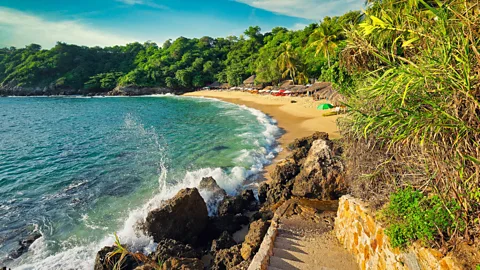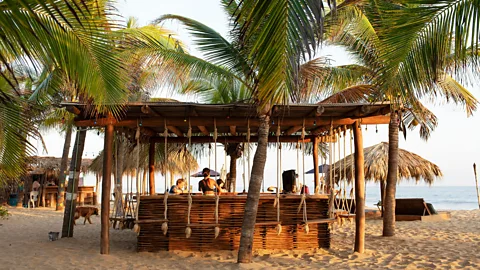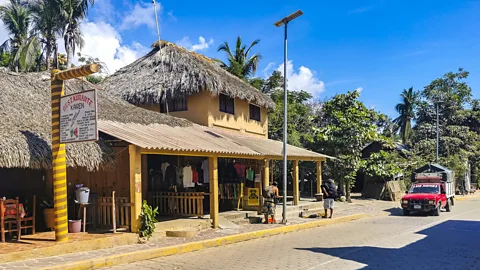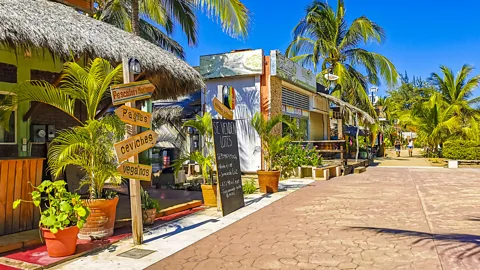Why Airfares Change | |
 | |
Have you noticed that airfares are always changing? Airlines set prices using complex algorithms based on a number of factors. Learn why airfares fluctuate and what you can do to keep your flights affordable. | |
|
Budget, Backpackers, Surfers, Beach Lovers, Naturalist, Hippie, Sun and Sand worshipers, Off the Beaten Path Paradise! Everyone is welcome at Zipolite!
Translate
A little about Playa Zipolite, The Beach of the Dead . . .
Playa Zipolite, Oaxaca, Southern Mexico, on the Pacific Ocean. A little bit about my favorite little get-away on this small world of ours.Zipolite, a sweaty 30-minute walk west from Puerto Angel, brings you to Playa Zipolite and another world. The feeling here is 1970's - Led Zep, Marley, and scruffy gringos.A long, long time ago, Zipolite beach was usually visited by the Zapotecans...who made it a magical place. They came to visit Zipolite to meditate, or just to rest.Recently, this beach has begun to receive day-trippers from Puerto Angel and Puerto Escondido, giving it a more TOURISTY feel than before.Most people come here for the novelty of the nude beach, yoga, turtles, seafood, surf, meditation, vegetarians, discos, party, to get burnt by the sun, or to see how long they can stretch their skinny budget.I post WWW Oaxaca, Mexico, Zipolite and areas nearby information. Also general budget, backpacker, surfer, off the beaten path, Mexico and beyond, information.REMEMBER: Everyone is welcome at Zipolite.ivan
Zipolite Blog Links
- Playa Zipolite
- Zipolite Entertainment, Party, Sports, Dance, Clubs, Music - - - Zipolite Entretenimiento, Fiesta, Deportes, Baile, Discotecas, Música
- Zipolite Food, Drink, Sunrise, Sunset - - - Zipolite Comida, Bebida, Amanecer, Atardecer
- Zipolite Nudist - - - Zipolite Nudista
- Zipolite ... Rentals, Camping, Hammocks, Apartments, House - - - Zipolite ... Alquileres, Camping, Hamacas, Apartamentos, Casa
- Zipolite Tours - - - Tours en Zipolite
- Zipolite Transportation and Rentals, Taxis, Bike, Moped, ATV - - - Zipolite Transporte y Renta, Taxis, Bicicleta, Ciclomotor, Cuatrimotos,
- Zipolite Yoga, Relax, Meditation, Temazcal - - - Zipolite Yoga, Relax, Meditación, Temazcal
- Budget Backpackers Off The Beaten Path - - - Mochileros económicos fuera del camino trillado
- Just For Fun ... by iVAn - - - Solo por diversión... de iVAn
- Near Zipolite - - - Cerca de Zipolite
- Travel Mexico - - - Viajes México
- ALL Playa Zipolite Blogspot Dot Com - - - TODO Playa Zipolite Blogspot Dot Com
Sunday, April 14, 2024
Why Airfares Change
Wednesday, April 10, 2024
Islas Marias: Nayarit’s ‘Galapagos Islands of Mexico’
Tuesday, April 2, 2024
Live in Mexico City? Here’s what you need to know about air quality
If you're fed up of how the pollution in Mexico City makes you feel, try our pulmonologist-approved tips to reduce your exposure. |
Monday, April 1, 2024
Mexico's controversial new 'superhighway' BBC Piero Zanetti/Getty Images Sunset on Playa Carizalillo beach in Puerto Escondido · Ida Pap/Alamy LGBTQ-friendly Zipolite is where you'll find lively ...
| Mexico's controversial new 'superhighway' - BBC Piero Zanetti/Getty Images Sunset on Playa Carizalillo beach in Puerto Escondido · Ida Pap/Alamy LGBTQ-friendly Zipolite is where you'll find lively ... |
Mexico's controversial new 'superhighway'
 Piero Zanetti/Getty Images
Piero Zanetti/Getty ImagesThe 104km Barranca Larga-Ventanilla highway radically reduces travel time to Oaxaca's beautiful and bohemian coast, but are local communities prepared for it?
The Oaxaca Coast has long been a dream destination of mine ever since a friend came home from a year in a yoga centre with tales of full Moon circles and plant medicine ceremonies held right on the beach.
Last December, after living in Oaxaca City, the capital of the eponymous state, for five months, I finally made it this beautiful Pacific coastline to watch waves pummel Playa Zipolite, Mexico's only official nude beach; admire the sun set on a sea cape that's said to be home to buried Aztec treasure; and try neo-shamanic healing in the bohemian town of Mazunte.
But getting there was no easy feat. Oaxaca's peaceful, fragile and largely undeveloped coast is sheltered by the Sierra Madre del Sur Mountains and was at that time reached by a famously vomit-inducing mountain road with endless hairpin turns from Oaxaca City. Taking seven to eight hours by car – or 10-12 hours by bus – the journey was hard to fit into my work schedule. My only other option was an expensive flight to coastal city Puerto Escondido. I went with a night bus, whose nonstop twists and turns left me feeling like I was riding an out-of-control rollercoaster.
Now, just a few months later, a quick weekend trip to the beach is entirely possible. A new 104km "superhighway" connecting Oaxaca City – named the best city in the world by Travel & Leisure in 2023 – to Puerto Escondido, the gateway to almost 600km of glorious coastline, finally opened in February 2024, 15 long years after its inception. It has radically reduced travel time to just 2.5 hours.
"The new highway is a game-changer for people who want an easy commute from the city to the beach," said Colleen Palmer, an American I met who was travelling with her husband. "People were buzzing about the highway when we left Oaxaca City and even more so when we arrived in Puerto Escondido."
 Ida Pap/Alamy
Ida Pap/AlamyI spent a little under two weeks on the so-called Oaxacan Riviera, though I could have easily spent two months. My visit was limited to a small string of villages: the sleepy, hippie town of Mazunte; the fishing village St Agustinillo; and the LGBTQ-friendly Zipolite. Decidedly unplugged, they're the type of places where ATMs are out of cash for a week and stable Wi-Fi is pretty much non-existent. Bouncing between the crystal healings of Mazunte and the lively beach bars of Zipolite hit the sweet spot.
But there is so much more to the coast. I could have headed south from Zipolite to hit up the nine bays, 36 beaches, coral reefs and lowland jungle of Huatulco National Park, or ventured inland into the mountains to cool off in the magical Copalitilla waterfalls.
Or I could have explored surf city Puerto Escondido, whose 20ft waves have earned it the title "Mexican Pipeline". Once here, it's a matter of taking a bus, taxi, colectivo (shuttle), boat, tour or private transportation for an hour or two to get to other destinations. For example, a few hours north of Puerto are the remote, biodiverse lagoons of Chacahua National Park, one of the least-developed destinations in the area. Fifteen minutes west from Puerto is Laguna de Manialtepec, which brims with rare birds, crocodiles and bioluminescent plankton.
Besides making it much easier for tourists to get here, the local government says that the road will increase trade between inland areas and the coast and make it easier for people in remote communities to access services like healthcare and education.
The more than 13bn pesos (around £609m) into the project reflects the government's growing investment in trade and travel infrastructure in Oaxaca. Other projects include the upcoming expansion of Puerto Escondido airport, which will allow for direct international flights to the coast, and the ambitious Interoceanic Corridor, which aims to rival the Panama Canal.
 Arkadij Schell/Getty Images
Arkadij Schell/Getty ImagesBut as is typically the case when travel becomes more accessible, the highway is a double-edged sword.
Take the highway
The 104km Barranca Larga-Ventanilla highway is an impressive feat of engineering and offers a smooth, quick ride to the coast. It has two traffic lanes and 15 on-and-off-ramps for surrounding communities.
While some construction is still going on, the road is now in use. It's free for everyone to use until September 2024, when a toll will go into effect for international and domestic tourists not from the state of Oaxaca.
Travellers can rent a car in Oaxaca City or take a bus or minivan. They can also support Coatlanes indigenous community affected by the highway by booking one of the vans offered by Ruta Coatlanes Costa.
On the one hand, a tourism boom could help Oaxaca, one of the poorest states in Mexico, "rise from the ashes, giving people better jobs and a better life, with more opportunities," said Nef Noyola, who was born on the Oaxaca Coast and now lives in Oaxaca City. Others I spoke to believe that coastal communities will benefit from access to services in Oaxaca City and overall improved connectivity between regions.
But gentrification across Oaxaca has people on edge, and as coastal communities grow in popularity with expats and long-term visitors, rising costs are driving residents away. Pollution threatens the pristine landscape, and even the surf itself is changing due to development.
A lack of government investment in infrastructure such as sewage treatment facilities means communities and the fragile environments they live in aren't prepared for hordes of tourists. Some Oaxaqueños feel abandoned by the government's lack of investment in service infrastructure to match that which was poured into the highway.
"Everyone is talking about this," said Nayola. "In many countries, governments will make sure everything is ready to receive more people before they build a road somewhere. In Mexico, they build stuff first and then they deal with what they were supposed to do before."
Meanwhile, the road has fuelled tensions between a local Indigenous group and the government. Members of the Coatlanes community say they ceded their land and cooperated with the government in the building of the highway for 20 years, with a promise that they'd have exclusive rights to operate transport. That promise wasn't upheld, inciting the community to block traffic within 24 hours of the road's inauguration.
 Arkadij Schell/Getty Images
Arkadij Schell/Getty Images"The quality of the life here is different if you are a white person or if you are Indigenous," said Isabella Matt, an Afro-Indigenous artist, activist and Puerto Escondido native. "In Puerto Escondido, we have a clear view of this. We have two different Mexicos: The real Mexico, and one the tourists know."
More like this:
- Mexico's ambitious new tourism megaproject
For those travelling to the region, being mindful and aware of the issues people face is essential, as is spending money in conscious ways, like opting out of resource-heavy accommodations (think beachfront resorts and high-rise hotels) in favour of ecologically responsible ones. Choosing simpler, more affordable accommodations may also help stop inflation.
"Just because you can pay for something more expensive doesn't mean you should," said Caleb Ramos Guzmán, who was born in and still lives in Zipolite. "Maybe you are here for a couple of weeks, but we stay here having to live under those prices with limited options."
Travellers should also try to travel sustainably by buying from small, locally owned businesses; minimising waste; and avoiding plastics. Being very mindful of water use is especially important in drought-stricken Oaxaca.
As the highway opens up the coast like never before, it's even more clear how precious and vulnerable this ecologically and culturally rich region is. While travellers like myself might rejoice at the prospect of a fast, convenient highway, it's essential to respect the wellbeing of the land and the people who live there by travelling lightly and consciously.
Get ‘la neta’ with our guide to Mexican slang
"Neta is one of the most common slang words in Mexico. Its origin traces back to the Spanish word “neto,” meaning “net” or “clear.” Over time, “neto” evolved into “neta,” and it was adopted as a fundamental part of Mexican Spanish. Today, the word has different meanings, including truth, honesty, authenticity, coolness and sincerity. It serves as a linguistic tool for expressing agreement, affirmation, or emphasis, depending on the context." Paulian Gerez, Writer |
|
Thursday, March 28, 2024
Prices are surging for eclipse flights, but there are still some deals
|
|
These US airlines are flying to the new Tulum airport in Mexico
|
|

